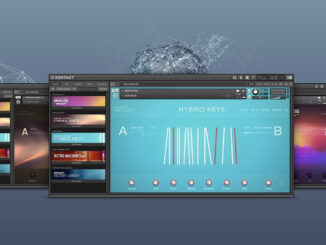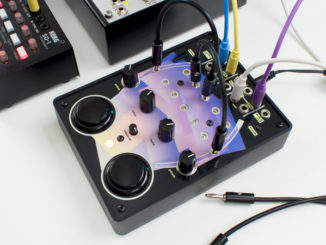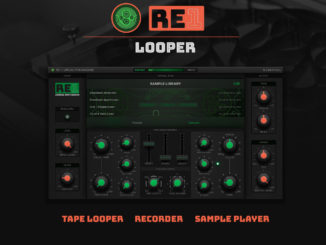Torso Electronics S-4 is a new portable sampler device bringing the tape workflow into the modern era paired with advanced sound sculpting features.
In November 2023, the makers of the inspiring T-1 algorithm sequencer announced the S-4. t is Torso Electronics’ second product and is also unique.
It’s a sampler and sound processor with a tape machine’s workflow. For the announcement, there were only a few demos available. Over the last weeks, Torso uploaded several small video demos showcasing the device.
______________________________________________________________________________
Article From November 16, 2023
The T-1 was the first product from the young Danish company Torso Electronics. A MIDI sequencer that broke new ground thanks to intelligent and user-customizable algorithms.
But it doesn’t stop with a MIDI sequencer. Today, Torso expands its portfolio with its first instrument. This is just as different and playful as the T-1.
“Sound is not just an auditory experience; it’s a tactile, living entity that evolves in real-time. The S-4 Sculpting Sampler is designed to be an extension of the artist’s imagination, offering an infinite canvas to mold, carve, and transform sound in the most intuitive way possible,” says Lars Buchholtz, CEO of Torso Electronics.
Torso Electronics S-4
The S-4 is a new portable sound design exploration machine or, in Torso’s words, a sculpting sampler. Sampling is only a part of what the instrument can do. It’s more of a door opener for many sound-sculpting adventures.
Torso’s first instrument is made of aluminum and has a beautiful, classic matte black finish. At only 820g, it is a very portable and light device that easily fits into any bag. I kind of get Monome Norns vibes looking at the hardware; who else?
The core of the S-4 is powered by a quad-core 1.5 GHz processor with 4GB flash memory. Sufficient power for long sound design sessions. 4GB, on the other hand, isn’t very much, I hope you can expand it externally via USB.
There are no surprises on the interface side: a high-resolution LCD color display, 21 tactile RGB buttons, and nine high-quality endless encoders.
A Sound Sculpting Engine
Small device, but big, powerful, and fun engine. Interestingly, Torso doesn’t go the groovebox direction with the S-4, but adapts the immediate, fun workflow of vintage tape machines to a modern area instrument. This is also reflected in the S-4 operation. Everything is very direct and made to do live experiments
The engine’s center is a stereo sampler with four parallel stereo tracks. You can feed them with live audio via the line inputs (real-time sampling) or import ready-made samples. You can use various modes, including stereo tape, offering a wide range of live audio and looping capabilities.
Since the device is still in full development, Torso can’t say all the details of what the sampling engine can do. But expect features like start and stop manipulation, time-stretch, and more. This material can then be routed to other processors, which opens further the sonic door.
Colorful Bouquet Of Creative Processors
First, it hosts a live granular processor with time-warping and pitch-shifting algorithms. The full feature set, including the maximum grain amount, are not yet fixed. But it shows in which direction it goes and that you can use the S4 as a quad granular sampler.
In addition to granular processing, the S-4 also offers exciting filtering options. But not the classic lowpass/highpass filtering. The Torso developers have implemented a morphing resonator powered by a 48-band tuned filter bank, giving you unique sound-shaping options.
All the in-depth details about the filter block are still missing, but I can imagine that you can achieve physical modeling-like, organic tones with it.
In two further engine blocks, you can add color and space to your sample content. The color section will feature a collection of effects made for sonic destruction, like bit-crushing, drive, distortion, and compression.
Space, on the other side, gives you everything to raise your soundscapes into sound clouds with a reverb/delay combo with pitch-shifting and shimmer.
Modulation A La Torso
Connectivity
On the back, the S-4 offers everything a live musician and studio producer needs: a stereo input/output on two mono 6.35mm line inputs/outputs, a stereo 3.5mm headphone socket, and a TRS-MIDI in/out.
Plus, you get analog sync in/out for working seamlessly with external gear and, a USB-C port, and a power supply input.
Not to forget, it also features a WiFI module with Ableton Link support. And you can turn it into a class-compliant USB audio interface with the option to expand the inputs and outputs via another USB interface.
(Early) First Impression
Since the device is still in development, it is difficult to make a first impression. But I really like what I see so far. Above all that Torso doesn’t go the groovebox route but of a modern tape sampler without being fixated on a grid.
Features like real-time granular processing and resonator are very promising, and I’m excited to see what will be possible.
Torso Electronics S-4 is available now for pre-order for 899€. Shipping starts in March 2024.
More information here: Torso Electronics







Looks really interesting. Yet, unfortunately memory could be a dealbreaker at that price. No SD card then?
I foresee Denmark vs Holland granular cage fight 😊
Interesting, but expensive. Lots of new samplers on the way. The wofi, chompy, tempera, and now this s4. I would buy them all up if I could but I’ll stick to my sp404 mk2, it really can not be beat for bang for the buck. If I was looking for granular I would probably put my money on the tempera or try out the lemon drop from 1010music for cheaper options. I’ll wait to hear more about it though.
I owned the T-1 and liked it a lot, but sold it bc it’s just not worth the price. This is even more expensive with obvious deficiencies from the get go, too many companies following the TE pricing route. Meant for an industrial design showcase in a museum, not someone’s studio.
On the homepage it says: “4 GB flash memory (sample pool)”
Hope that there is more memory for the “tape machine” functionality !?
Also NO SD card is an oversight imho.
All other specs and that it can function as an effects processor as well as a sound card is impressive!
just read: “load samples from the S-4’s flash memory or an external drive.”
external drive could save the day …
It does have USB-C, which would be fast enough for external.
It’s doing the sort of thing that I would use the MacBook for. I guess there’s some sort of synergy between hardware and software that’s cool in a tractor product but explain to me why this can’t just be software.
This is definitely an investment that should be justified by its capacity as a standalone unit. The need for external memory (and not battery power) is such a letdown. Why do companies keep doing this! A terrible example is the MC-707. They neutered it. I love the idea of a tape machine style recording. But then you need the memory to back it up right. There is a gap in the market for a great desktop sampler/groovebox with a smart UI.
Why is it so hard to have at least two stereo outs on a multi track sampler?
you can expand the two audio output number with an audio interface via the USB-C port.
But that is where the external SSD goes, or how the unit is to be powered if you don’t want to bring along the big power brick… now we are into USB-C hub territory to plug in all these different things. Not elegant.
don’t forget the unit has 4GB of internal memory. Filling these with audio takes a while, especially with the workflow that you don’t have 10,000 samples on the device but record using tape-style method, loop the content on the fly, etc. It doesn’t want to be an MPC or Maschine where you buy tons of expansions etc. where you need a lot of GBs.
iPad with a soundcard, 4 tracks, 8 tracks, 32 tracks… all the same effects, midi, plugins, softsynths, inter-app audio.
This is just 4 tracks, limited by a hardware paradigm that plugging a soundcard into an ipad would totally destroy?!!?!?
sure, iPad is a killer device but requires additional things. Two different workflows. There are musicians who don’t want to use iPads or any sort of personal computer things but prefer standalone devices that runs on its own. I uses both worlds, iPads and standalone devices.
Well, both have CPU’s, RAM, Storage and the ability to interface, both have an OS, both are computing devices and I’m going to break it to you gently…the iPad is a standalone device.
The very slight drawback of having to plug in an audio interface is utterly outshone by the incredible software available for the iPad.
The S4 is a $300 device wearing the naked suit.±
There’s just no little boy laughing and pointing.
As I said, I’m using both and I support both worlds. There are price difference sure, a good iPad Pro also costs $799 minimum + a good interface ($200 min) so it’s also not on the super cheap side. I mean with standalone that you turn it on and it works without extra installation of apps or so.
I love to use iPads for live performances. I had good and bad experiences (audio glitches using an audio interface, app crashes…). I can’t understand that people don’t want to deal with extra audio interface, OS updates, etc.
Both worlds are fine and good to have the choice on the market. Everyone should work the way they like.
Don’t need an iPad Pro, the base model would destroy those tasks.
Even the cheapest iPad is ridiculously OP these days, it can run iOS Logic without breaking a sweat.
The problem is that this is a phase we see way too much of recently, super costly one-off devices (see Teenage Engineering etc etc) that only really appeal to people with overblown G.A.S. and a weird need for bragging rights.
I uses an OP-1 Field and an iPad. I don’t see the OP1 as a “one-off devices”, it inspires more than my 200+ apps on my iPad. It just how the workflow is and how quick you come up with ideas. And again it’s a workflow thing. Maybe I have weird needs but I’m happy with it. That’s the most import thing. One part can be happy with iPads, others with standalone devices.
It doesn’t have to be a fight which is better or cheaper. Everyone should use gear that inspires.
No matter how much power they have or how much they cost more or less. Good examples are Trentemoller or Alessandro Cortini with NIN. They use the OP-1 on the big stage. They could also use an iPad. Why, probably because the device fits their own workflow.
Far from everyone wants to support Apple
darn tootin
I have the T1. When it’s good it’s great but it can be totally mystifying and frustrating also. I’m really not feeling this device though. A 1010 Music BlackBox (three stereo outs) plus some decent FX pedals will absolutely beat this hands down IMO